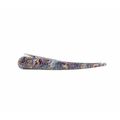Bird - Grey wagtail 1970s Coloumaster postcard
- Condition : Used
- Dispatch : 2 Days
- Brand : None
- ID# : 34042997
- Quantity : 1 item
- Views : 411
- Location : United Kingdom

- Seller : justthebook (+1703)
- Barcode : None
- Start : Sun 14 Nov 2010 19:11:19 (EDT)
- Close : Run Until Sold
- Remain : Run Until Sold
Checks/Cheques
 for 1 item(s) edit
for 1 item(s) edit
Shipping Calculator
More Listings from This Seller view all
Seller's Description
- Postcard
- Picture / Image: Grey Wagtail
- Publisher: Photo Precision Ltd. (Colourmaster) WB9
- Postally used: yes
- Stamp: 10p definitive
- Postmark(s): Lancaster & Morecambe 1980 slogan + Preston cds
- Sent to: William Allen Lane, Lindfield, West Sussex
- Notes & Key words: gentle wear from postal use
------------------------------------------------
Postage & Packing:
UK (incl. IOM, CI & BFPO): 99p
Europe: £1.60
Rest of world (inc. USA etc): £2.75
No additional charges for more than one postcard. You can buy as many postcards from me as you like and you will just pay the fee above once. (If buying postcards with other things such as books, please contact or wait for invoice before paying).
Payment Methods:
UK - PayPal, Cheque (from UK bank) or postal order
Outside UK: PayPal or Google Checkout ONLY please. NO non-UK currency checks or money orders (sorry).
NOTE: All postcards are sent in brand new stiffened envelopes which I have bought for the task. These are specially made to protect postcards and you may be able to re-use them. In addition there are other costs to sending so the above charge is not just for the stamp!
----------------------------------------------
Text from the free encyclopedia WIKIPEDIA may appear below to give a little background information:
*************
The Grey Wagtail (Motacilla cinerea) is a small member of the wagtail family, Motacillidae. The species looks similar to the Yellow Wagtail but has the yellow on its underside restricted to the throat and vent. Breeding males have a black throat. The species is widely distributed, with several populations breeding in Europe and Asia and migrating to tropical regions in Asia and Africa. They are usually seen on open marshy ground or meadows where they walk solitarily or in pairs along the ground, capturing insects that are disturbed. Like other wagtails, they frequently wag their tail and fly low with undulations and they have a sharp call that is often given in flight.
This slim wagtail has a narrow white supercilium and a broken eye ring. The upperparts are grey and the yellow vent contrasting with whitish underparts makes it distinctive. The breeding male has a black throat that is edged by whitish moustachial stripes. They forage singly or in pairs on meadows or on shallow water marshes. They also use rocks in water and will often perch on trees. They have a clear sharp call note and the song consists of trills.
The breeding season is April to July and the nest is placed near fast running streams or rivers on an embankment between stones and roots.[2] In Europe the nests are often made in holes in manmade structures. The clutch consists of 3-6 speckled eggs and multiple broods may be raised with declining numbers in the clutch in subsequent broods.[7] The usual clutch size is five in Ireland and the breeding success is about 80% with predation of eggs or chicks being the main cause of breeding failure.[8] The Canary Islands population typically have smaller clutches and the breeding season is not as short and well marked as in populations at higher latitudes.[9] The incubation period is about two weeks with chicks fledging within a fortnight. They live for a maximum of 8 years in the wild.[10][11]
In some parts of the its range the White-throated Dipper nests in the same habitats as the Grey Wagtail and there are some records of interspecific feeding of dipper chicks by nesting wagtails.[12]
These birds feed on a variety of aquatic invertebrates including adult flies, mayflies, beetles, crustacea and molluscs.[13]
In winter, they roost in small groups.[14] Wintering birds have been known to return to the same sites, sometimes a small urban garden, each year.[15]
Adults often have parasitic ticks, Ixodes ricinus, which can harbour Borrelia and thus can potentially disperse Lyme disease over a wide region.[16] Coccidia such as Isospora sp. are known in this species.[17] The Common Cuckoo is sometimes a brood parasite of this species.[18] and Kestrels may sometimes prey on them.[19]
Listing Information
| Listing Type | Gallery Listing |
| Listing ID# | 34042997 |
| Start Time | Sun 14 Nov 2010 19:11:19 (EDT) |
| Close Time | Run Until Sold |
| Starting Bid | Fixed Price (no bidding) |
| Item Condition | Used |
| Bids | 0 |
| Views | 411 |
| Dispatch Time | 2 Days |
| Quantity | 1 |
| Location | United Kingdom |
| Auto Extend | No |



















